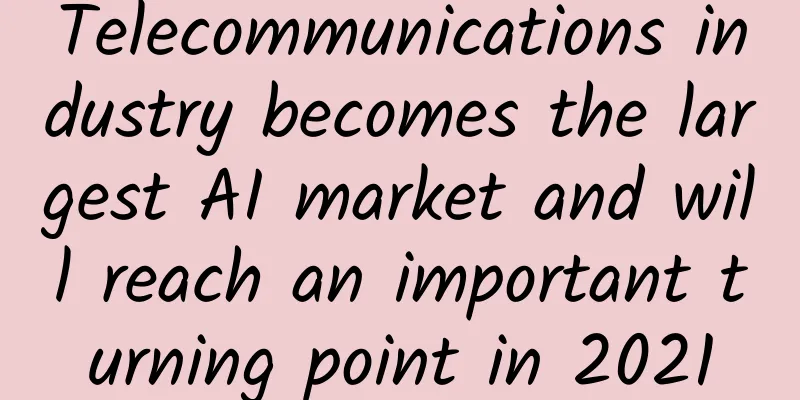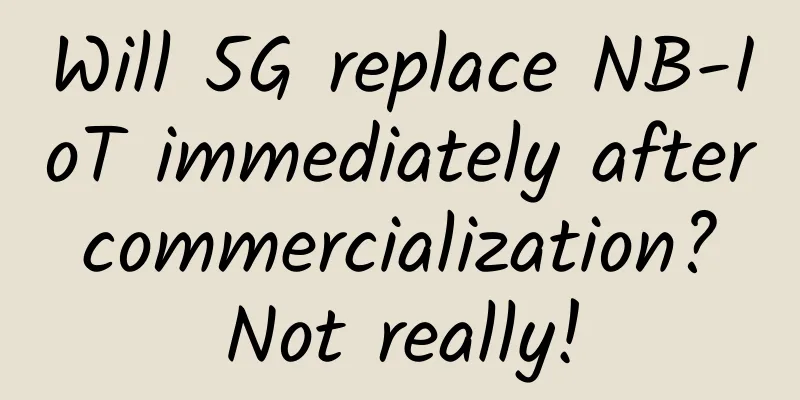Telecommunications industry becomes the largest AI market and will reach an important turning point in 2021

|
Tractica/Ovum, a world-renowned market research company under Informa, conducted a study of nearly 300 real AI usage scenarios in 30 fields. The results show that the AI adoption rate in telecommunications, mass, advertising, commercial services and healthcare will be in the leading position during the period 2018-2025. Among them, the telecommunications field is particularly active in AI technology and is currently the largest AI market segment. According to Tractica/Ovum forecasts, by 2025, the global telecommunications industry's investment in artificial intelligence software, hardware and services will reach US$36.7 billion. Among them, the overall AI use case software market in the telecommunications industry will increase from US$315.7 million to US$11.3 billion in 2025 at a compound annual growth rate of 48.8%. "The telecommunications industry is the largest AI market among the 30 sectors we studied, accounting for the largest AI market share. The main driving force behind the adoption of AI technology in the telecommunications market is the transformation of telecommunications networks towards automation, and also because telecommunications operators are facing cost and revenue challenges. As operators cope with these challenges, AI is one of the tools they must use," Aditya Kaul, research director at Tractica/Ovum, told us in an exclusive interview with C114. Multiple challenges emerge simultaneously, AI becomes an important life-saving straw In 2017, the revenue per bit of many network operators was lower than the cost per bit. In addition, telecom operators are also facing the challenge of digital transformation under the threat of fast and efficient Internet giants. Most importantly, telecom operators must know how to better manage and operate the dazzling next-generation 5G/IoT networks. Aditya Kaul analyzed that multiple challenges are erupting together, and AI has become one of the tools that telecom operators must use to deal with these challenges. On the one hand, the growth rate of network deployment costs of telecom operators has exceeded the growth rate of revenue. Revenue has remained flat, but costs have continued to increase. Therefore, they need to actively adopt AI technology to reduce operating expenses (OPEX). On the other hand, telecom operators' revenue has been severely squeezed and impacted by OTT service providers. Internet service providers have more flexible, agile and automated networks. They do not have the traditional telecom operator architecture and will adopt AI very quickly. Internet manufacturers currently account for most of the application revenue, which has squeezed the revenue of telecom operators. At the same time, telecom operators also have to face the consolidation of the telecom market, especially in the European telecom market. In addition, there is the upcoming 5G challenge - telecom operators must accelerate the deployment of 5G, otherwise they will fall behind, and 5G also brings challenges in capital expenditure (CAPEX) in the next 3-5 years. Network optimization becomes the largest AI use case in the telecommunications market According to Tractica/Ovum's research, AI technology has five main use cases in the telecommunications field: network/IT operations monitoring and management, customer service and marketing VDAs (virtual digital assistants), intelligent CRM systems, customer experience management and network security. Among them, network/IT operations monitoring and management will become the largest AI use case in the telecommunications industry. Tractica/Ovum predicts that telecom operators' spending on AI for network operations monitoring and management will account for 61% of the telecom industry's AI spending during the period 2016-2025. Aditya Kaul explained to us: "Network/IT operations monitoring and management is actually network optimization, which means using AI technology to understand what is happening on the network in real time and then dynamically changing the network to deliver services. AI-driven network management solutions include network design, network load balancing, reducing switching between base stations, etc." He added that the key technologies used include deep learning, machine learning, natural language processing, etc., and the large-scale deployment of SDN/NFV and 5G will drive 2021 to become a turning point for network automation.
In addition to the network side, telecom operators can also use AI technology for customer service. Tractica/Ovum research found that telecom operators are using AI technology extensively for customer service chatbots. "This is also to reduce costs. Telecom operators have huge costs and investments in voice customer service centers, and chatbot mechanisms can be a supplement. In some research cases, telecom operators have reduced operating costs by 30% using AI chatbots." In addition, in terms of marketing, telecom operators can use chatbots to conduct customer data surveys. At the same time, telecom operators are also using AI technology for intelligent CRM systems to maintain customer satisfaction, reduce customer churn, and improve sales team efficiency. "Intelligent CRM systems enable operators' marketing and sales teams to combine existing CRM data, customer data, social media data, news data, weather data, etc. through AI technology, so that they can better make market forecasts in advance and adjust service marketing." Aditya Kaul said. 5G will develop side by side with AI and reach a turning point in 2021 The Tractica/Ovum analyst said AI is a very important part of 5G, which will be accompanied by the maturity and larger-scale deployment of SDN and NFV functions. Tractica/Ovum's research results show that the growth of AI spending in the telecommunications industry will actually start from 2020 and 2021, especially the large-scale growth, which will start from 2021, which is consistent with the growth curve of 5G. "We believe that 5G capital expenditure will start from 2021, and there is a significant correlation between 5G and AI. In fact, in our view, 5G and AI are developing side by side." Aditya Kaul pointed out that the entire 5G transformation is aimed at making the network more autonomous, automated, software-defined, and resilient. He said that on the one hand, this is a challenge for operators because capital expenditures are growing, but at the same time they can deploy more automated AI technology-type applications and services, and more SDN and NFV functions will be launched at that time. These technologies will develop side by side and work together to achieve a more agile and resilient network. At this stage, some SDN and NFV functions have been deployed on 4G networks, and then they will gradually transition to 5G. It should be noted that this is not just the construction of a pure 5G network, but software-defined elements must also be implemented in 4G networks. Aditya Kaul believes that the transition from 4G to 5G is completely different from the transition from 2G to 3G or even 3G to 4G. 5G actually runs everything under one system. 5G will work together with all these (2G/3G/4G) legacy networks to develop, while adding some new features. The entire 5G deployment cycle will be very long. He believes that the 5G network deployed in the early stage will not be an automated network because it still contains a lot of legacy elements. According to Tractica/Ovum's expectations, some major telecom operators will achieve network automation or near-automation by the end of 2024, and the turning point will be around 2021. Talent shortage and organizational structure issues still need to be overcome Telecom operators still face challenges in converting massive amounts of data into AI capabilities that can be applied in practice. First of all, talent shortage is a common problem faced by the global AI industry, and the telecommunications industry is no exception. Aditya Kaul pointed out that both telecom operators and Internet companies and other AI market participants are in urgent need of AI engineers. The shortage of AI skills and talents is a very serious problem. In his view, the organizational structure of telecom operators is another shortcoming that hinders the use of AI technology in the telecommunications industry. "The organizational structure of telecom operators is not very adaptable to new technologies, lacks flexibility, and cannot launch services quickly. This requires telecom operators to have a new operational mindset, but this may take some time." However, some of the world's leading telecom operators have already started to take action. Telefonica, a global Tier-1 telecom operator, is currently working hard to transform from a traditional operator to a data-driven company and has established a new data architecture. Aditya Kaul said that in another decade, the global communications market will be a completely different ecosystem, and there will be not only telecom operators, but also market participants such as Facebook, Google, Space-X, OneWeb, etc. Telecom operators must actively carry out digital transformation and seize the opportunities of 5G and AI in order to survive in the more competitive future market. |
<<: Little-known tips for ordinary users to install broadband at home
Recommend
How data centers work today and in the future
The data center of the future will rely on cloud ...
ZJI: 600 yuan/month-E5-2637v2/16GB/1TB SSD/20M CN2/Hong Kong Kwai Wan Data Center
Last month, ZJI offered a monthly discount for Ho...
V5.NET: 30% off for first order from new customers, Hong Kong E5 server as low as HK$385/month
V5.NET is a business that provides independent se...
Behind the 13 consecutive fines: When will the operators’ “low-price bidding” stop?
According to people familiar with the matter, a c...
Experts at the 5G Evolution Summit discussed: How to promote the sustainable development of 5G?
Currently, 5G has been commercialized on a global...
[Black Friday] Sharktech: 50% off on all cloud products, 10Gbps unlimited traffic server $349/month-2*Gold 6148/128G/2TB NVMe/Los Angeles and other data centers
Sharktech also released a promotion during this y...
10gbiz 40% off on all VPS hosts, Hong Kong CN2 GIA/Los Angeles CN2 GIA lines available
10gbiz's promotion is still going on, with 40...
Kunpeng University Tour is coming soon. How can the Sichuan-Chongqing Twin Cities Economic Circle be without Kunpeng?
[51CTO.com original article] At 2:00 pm on Thursd...
Paving the way for innovative applications, all-optical networks are moving from enterprises to ordinary people's homes
[[386853]] From dial-up to ADSL, and then to fibe...
IPv4 and IPv6: Is the Internet Facing a Split?
The Internet is facing a technological split, and...
2G/3G network withdrawal and user migration to 4G
Recently, Strategy Analytics analyzed the current...
Domestic developers report: Apple App Store suspected of infringement and monopoly
On August 7, a team of domestic developers and le...
A Chinese original praised by five academicians: Feisuan fully automatic software engineering platform is launched globally
"You only need to input the flowchart, and t...
Customized COSU equipment management solutions
Corporate Owned Single-Use Units (COSUs) are used...



![[Black Friday] Ramnode offers free gifts for as much as you charge, cloud servers in data centers in Los Angeles/Seattle/New York/Netherlands](/upload/images/67cabceb5b716.webp)





